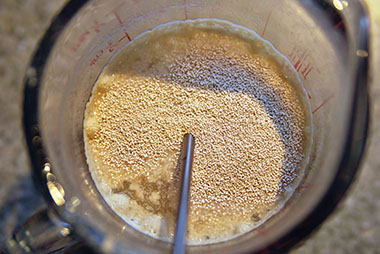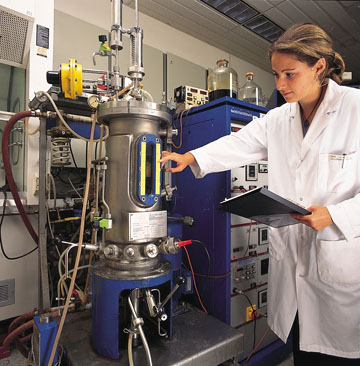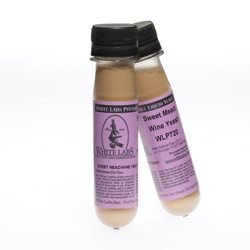
The most basic definition of alcoholic fermentation is the enzymatic conversion of sugars into alcohol, and more specifically in winemaking, fermentation is the conversion of glucose and fructose into ethanol with carbon dioxide (CO2) gas as a major by-product, accompanied by the release of heat.
Although ethanol and CO2 are major by-products, yeast also metabolizes other substances (termed “substrates” in techno-speak) into a vast array of more or less significant by-products, all of which can have varying impacts on a wine’s organoleptic qualities depending on a variety of conditions.
This article outlines the major metabolic functions within S. cerevisiae yeast cells to understand how major substrates — sugar, nitrogen, fatty acids and esters, organic acids, and sulfur — found in grape juice are converted into all those wonderful aromas and flavors that we seek so much, as well as undesirable by-products.
Sugar Metabolism
Glucose and fructose are the major sugars and substrates used as sources of carbon by S. cerevisiae yeast — they occur in grapes in roughly equal proportions. These monosaccharides cross cell membranes and enter cells via the use of specialized transport proteins to begin their metabolic journey. At this point, yeast cells must have sufficient oxygen available to regenerate energy for cell functions and build up cell biomass, in what is referred to in biology as respiration, hence the need to supply oxygen to yeast very early on at inoculation. Cell metabolism then switches from a respiratory to a (anaerobic) fermentative mode due to the high amounts of sugars found in grape juice. Yeast cells are equipped with a plethora of enzymes that enable the biochemical reactions described here.
In the first part of this metabolic journey, glucose and fructose are first converted into glycerol, in the order of 10 g/L (1%), and excreted out of cells. Glycerol is a colorless, odorless, viscous, sweet-tasting liquid, and the third-most abundant compound (after water and ethanol) in wine. Although glycerol is sweet, it is masked by other compounds in wine and therefore does not impart perceptible sweetness; however, it has been shown to positively influence overall flavor intensity.
Concurrently, glucose and fructose are synthesized into pyruvic acid, the most important intermediate by-product in yeast metabolism, and which is then decarboxylated (CO2 is being released) into acetaldehyde; this is the beginning of true fermentation. It is acetaldehyde (also known as ethanal) that is actually being converted into and excreted out of cells as ethanol.
Approximately 180 g of glucose and fructose result in 92 g of ethanol and 88 g of CO2. Theoretically then, ethanol is produced at a rate of 92/180 or 51% of fermentable sugars, but this varies by yeast strain based on the strain’s conversion ability. Based on the density of ethanol, making some assumptions about loss of CO2, accounting for some sugar that is diverted towards other metabolic functions (e.g., in the production of glycerol), and converting weight measurements into volume, the potential percent alcohol by volume (% alc/vol), or PA, can be determined as per the following equation:
PA = 0.57 x Brix
Brix is the amount of sugar, in grams, in 100 g of juice. For example, a must with 23 °Brix could produce about 13.1% alc/vol.
Brix and specific gravity (SG), measured at 20 °C (68 °F), are related as per the following equation:
Brix = 261.3 – (261.3 / SG)
Some researchers have calculated that the actual amount of ethanol is closer to 0.55 x Brix while others have determined experimentally that the actual conversion is lower due to conversion into other by-products and ethanol evaporation, and that it is closer to the following equation:
PA = 0.57 x Brix – 0.63
And so, our must at 23 °Brix (SG 1.097) is predicted to potentially produce about 12.5% alc/vol instead of 13.1% if fermented to dryness.
Some small amounts of pyruvic acid and acetaldehyde will escape the cell but are quickly sequestered by sulfur dioxide (SO2), either added by the winemaker or the little that is produced by yeast. Some yeast strains can produce more significant amounts of acetaldehyde, which can impart oxidative aromas and flavors if excessive and/or there is insufficient SO2. Sulfite must be used with care here as it can hasten acetaldehyde (and glycerol) bioproduction, particularly at high temperatures or if there is not enough yeast nutrients.
Various other metabolic pathways are then invoked once pyruvic acid, acetaldehyde and ethanol are produced, which give rise to a whole array of new compounds in varying amounts depending on the yeast strain. Those of enological significance include: Succinic acid, which can contribute in the order of 10% of a wine’s total acidity (TA); acetic acid, produced in the order of 100–300 mg/L under normal winemaking conditions, and significantly more in high-Brix wines, and which contributes to aromatic complexity and volatile acidity (VA); higher alcohols (e.g., isobutanol and isoamyl alcohol) that can contribute positive aromatic characteristics or which can impart solvent-like or other off aromas or mask other aromas at high levels if fermentation is not managed carefully; and diacetyl, the compound that imparts buttery aromas.
Being glucophilic, S. cerevisiae will preferentially ferment glucose at a faster rate than fructose, and therefore, a wine fermented to dryness will have less residual glucose than fructose, and any glucose and fructose remaining in the wine at the end of fermentation contribute to residual sugar. If two wines have the same residual sugar concentration, the one with more fructose will taste sweeter.
Nitrogen Metabolism
Yeast needs an adequate supply of nitrogen to perform its carbon-conversion tasks to manufacture a whole host of nitrogenous macromolecules (e.g., proteins) needed to sustain its activities and remain viable. It does so by assimilating and using inorganic and organic nitrogen from ammonium ions and amino acids (the building blocks of proteins), respectively, without which it can start producing stinky volatile sulfur compounds (VSCs) or simply die. An adequate supply of nitrogen is also essential for the proper development of fermentation-derived aromas and flavors.
Grape juice contains many other nitrogen compounds including peptides, proteins, nucleic acids and vitamins, but S. cerevisiae can only assimilate ammonium and α-amino (alpha-amino) acids. Grape-derived proteins are resistant to the action of yeast proteases (the enzymes that break down proteins) and are not assimilated during fermentation.
S. cerevisiae yeast preferentially assimilates nitrogen from ammonium, then from α-amino acids, and therefore, ammonium may become depleted during yeast fermentation. Different yeast strains consume nitrogen at different rates, which can be affected by environmental factors, such as ethanol content. Nitrogen depletion also increases in the presence of oxygen. Yeast can theoretically ferment with a good supply of ammonium as the only source of nitrogen; however, α-amino acids give rise to higher alcohols, some of which are precursors to odiferous ester compounds.
Low nitrogen supply can cause a stuck fermentation, higher levels of acetaldehyde with some yeast strains, excessive production of stinky VSCs, such as the rotten-egg-smelling hydrogen sulfide (H2S), and increased higher alcohol and reduced ester production with commensurate off aromas and flavors. Sulfides result when yeast starts consuming sulfur-containing amino acids, while higher alcohols can mask the fruity character of fatty acid ethyl and acetate esters produced via fatty acid and ester metabolism (read on).
However, excessive nitrogen can lead to too-rapid of a fermentation that can affect dynamics and negatively impact aromas and flavors; produce biogenic amines, some of which are known to have physiological effects; produce excessive amounts of acetic acid and ethyl acetate that would increase VA; generate high levels of VSCs (e.g., H2S); and support the growth of undesirable microbes that could cause spoilage. And specifically, excessive inorganic nitrogen in grape juice can also cause very rapid yeast population growth, which could then starve and stress yeast later in the fermentation cycle.
The minimum amount of nitrogen needed in juice for a good fermentation is dictated by viticultural practices, condition of the grapes (e.g., amount of rot, fruit damage), and, most importantly, the yeast strain and amount of sugar. Temperature, pH and pre-fermentation processing (whites vs. reds) have a secondary impact. The amount of nitrogen that can be assimilated and used by yeast is referred to as yeast assimilable nitrogen, or YAN, and is expressed as a concentration of nitrogen in mg/L and written as mg N/L. YAN can be measured by titrimetric or enzymatic methods.
Diammonium phosphate (DAP), ammonium sulfate, or complex, balanced fermentation supplements containing an adequate supply of amino acids, peptides, vitamins, unsaturated fatty acids, sterols, minerals, inactivated yeast cell walls and other supplements are recommended to enhance fermentation kinetics. Functionally important vitamins naturally occurring in grape juice include: B1 (thiamine), essential for yeast growth; B2 (riboflavin), primarily used in building a host of enzymes and coenzymes; B5 (pantothenic acid), which is used by yeast to synthesize fatty acids; and B6 (pyridoxine), which is used as a coenzyme in the metabolism of important amino acids, polysaccharides, and fatty acids needed by yeast.
Fatty Acid and Ester Metabolism
Yeasts must synthesize great amount of sterols and unsaturated fatty acids into phospholipids (specific kinds of lipids, or fatty acids) during the growth phase of fermentation to build their plasma membranes (cell wall) and support the transport of compounds into and out of cells.
Sterols play an important role in regulating membrane permeability and fluidity, and also regulate the cellular metabolic cycle in aerobic conditions. Since these biosynthetic processes are aerobic, meaning they require oxygen, aeration during the yeast’s growth and exponential phases can be beneficial; alternatively, exogenous preparations containing sterols and unsaturated fatty acids can be used.
This fatty acid metabolism does however also produce toxic (to yeast) fatty acids, hence why it is often recommended to add yeast hull supplements to adsorb these substances.
The ester metabolism synthesizes fatty acid ethyl esters and acetate esters, responsible for the many fruity aromas in wine. Examples of fatty acid ethyl esters and their aromas include ethyl butanoate (fruity/flowery), ethyl hexanoate (tropical fruit/banana) and ethyl octanoate (ripe fruit/flowery). Examples of acetate esters include ethyl acetate (glue), isoamyl acetate (banana), and phenylethanol acetate (rose).
Organic Acid Metabolism
Some S. cerevisiae strains are also equipped with specific enzymes capable of converting malic acid into lactic acid; these could prove useful prior to conducting an MLF using lactic acid bacteria, where desired. However, unlike MLF where malic acid is converted “straight” into lactic, malic acid can be metabolized by yeast enzymes into pyruvic acid, which is then metabolized into, for example, acetaldehyde and ethanol. Such yeast strains will therefore have greater impacts on TA changes and amount of ethanol produced.
Certain S. cerevisiae yeast strains do however have a potentially nasty side; they may contain an enzyme, cinnamate decarboxylase, capable of enabling the decarboxylation of hydroxycinnamic acids (specific kinds of phenolic acids) into their volatile forms, 4-vinylphenol, 4-vinylguaiacol and 4-vinylcathecol, which can lead to off aromas, such as pharmaceutical or medicinal, burnt rubber and barnyard.
Red wines will tend to have lower levels of vinyl compounds than whites because of the higher concentration of phenolics in reds, which have inhibitory effects on S. cerevisiae cinnamate decarboxylase enzymes.
Given the many metabolic activities involving acids (e.g., production of succinic and acetic acids, transformation of malic into lactic acid), changes in TA are very complex to predict. To assess changes, TA should be measured just prior to and immediately following fermentation.
Sulfur Metabolism
Yeast can assimilate and metabolize organic sulfur from naturally occurring or yeast-derived sulfur amino acids as well as inorganic sulfur from sulfates and sulfites into VSCs, most of which cause wines to become flawed if produced in excessive amounts. Sulfates can originate, for example, from the use of copper sulfate in the vineyard to prevent mildew. Sulfite is also a by-product of yeast fermentation, typically in the order of 10 mg/L but potentially greater with some strains.
We noted earlier that glucose is diverted to other metabolic pathways and it does not necessarily get all converted into ethanol. Some glucose is required and assimilated by yeast to manufacture amino acids, which are then used in sulfur metabolism.
Molecular SO2 and bisulfite (HSO3–) ions are assimilated by yeast cells and, given the higher pH inside yeast cells compared to the wine medium, these substances then exist primarily as bisulfite (HSO3–) ions and to a lesser extent as sulfite (SO32–) ions. HSO3– is reduced to hydrogen sulfide (H2S), which can become excessive if great amounts of sulfite are used or generated by the yeast.
Similarly, any sulfate (SO42–) assimilated by cells can be reduced to sulfite and then to sulfides. Sulfides can become incorporated into sulfur-containing amino acid synthesis and further exacerbate VSC production. Sulfides that are not incorporated into these amino acids can form and secrete potentially large amounts, up to 290 mg/L, of H2S. Any sulfite not reduced is secreted out of the cell into the wine and contributes to free SO2.
There is one sulfur amino acid worthy of mention here: L-cysteine. This amino acid is involved in the synthesis of the tripeptide glutathione (GSH), a compound known for its high antioxidant power, hence, it is often a component of inactive dry yeast (IDY). GSH occurs naturally in grapes but it needs to be supplemented, where allowed (not all winemaking regions allow its use), as it is consumed in oxidation–reduction reactions in the must before fermentation kicks in. Sulfides can also react with ethanol or acetaldehyde to form ethanethiol and ethanethioacetate, two powerful and stinky VSCs. Unusually high levels of H2S and ethanethiol also point to yeast-related problems during fermentation.
Aroma & Flavor Compound Changes
Some juice contains many naturally occurring active aromas, referred to as primary aromas, while yeast produces many other ones, or secondary aromas, as described above. But many of the naturally occurring aroma compounds are “not active,” i.e., they are nonvolatile and odorless.
S. cerevisiae yeast uses specific endogenous enzymes to transform these odorless aroma and flavor precursors in grape must into varietal compounds and a whole host of secondary aromas that shape a wine’s organoleptic profile.
Many of these precursors belong to a class of compounds that includes monoterpenes and norisoprenoids, responsible for a range of aromas from floral to citrusy to kerosene-like in the case of Riesling, and thiols, such as 3-mercaptohexan-1-ol (3MH) and 3-mercaptohexyl acetate (3MHA), responsible for the characteristic passion fruit, tropical fruit, and box tree aromas in Sauvignon Blanc.
These compounds are not active because they are tied to other molecules, quite often sugar molecules, which renders them nonvolatile and odorless. The role of the enzymes is to break loose that component from the binding molecule and allow it to become active. For example, glycosidase enzymes cleave the bond between monoterpenes or norisoprenoids and the sugar component. Once freed, these compounds become volatile and express their characteristic aromas and flavors. Because endogenous glycosidases tend to have poor stability at the low pH found in juice and wine and they are also inhibited by ethanol, wine may need to be supplemented with commercial glycosidase preparations to liberate aromas from their binding sugar component.
Yeast Autolysis
Once yeast cells have completed their metabolic cycle and have run out of nutrients and die, the dead yeast cells, or lees, form a layer of sediment at the bottom of the fermentation vessel. Wine lees also contain grape particulates, bacteria, tartaric acid and/or tartrate crystals, polysaccharides and, in red wines, protein–tannin complexes resulting from the interaction between proteins and tannins. If left to interact with the wine, β-glucanase enzymes from cell walls will break down the dead yeast cells, in what is referred to as yeast autolysis, causing the degradation of cell macromolecules and release of breakdown by-products, the major ones being mannoproteins and β-glucans.
β-glucanases can remain active for several months following cell death, which allows for extended aging of the wine “on the lees,” what the French refer to as sur lies, to add further aroma and flavor complexity. Wines ages on the lees are often described as bread-like or yeasty, as well as having a creamier mouthfeel and more body.
Yeast autolysis is a key aspect in the production of buttery, diacetyl-rich Chardonnays and sparkling wines produced in the traditional method and is used increasingly more in red winemaking. Where extra mouthfeel and buttery aromas are desired, a technique known as bâtonnage, or stirring the lees, is used to hasten the effects of yeast autolysis. If the lees are not stirred systematically and are left in wine for too long, yeast autolysis can become a source of H2S and other stinky VSCs. Lees should be stirred two or three times per week during sur lies aging.
Yeast Selections
There are many strains of S. cerevisiae yeasts to choose from to craft a desired style of wine based on grape variety. Different strains produce different by-products and varying amounts; that’s what yeast selection is all about. But not all strains are created equally; they will all metabolize differently and react differently to various environmental stimuli, and so, a yeast strain must be chosen as a function of expected environmental conditions (e.g., temperature, potential alcohol production) and fermentation impacts (e.g., VA, SO2 and H2S production, nutrient needs), and desired wine style (e.g., varietal character). Manufacturers of cultured yeasts provide this data to help winemakers match the desired style and variety to specific strains to choose from.




